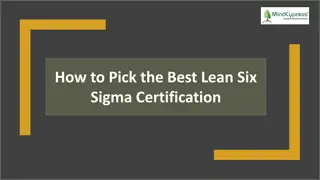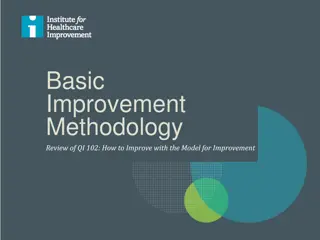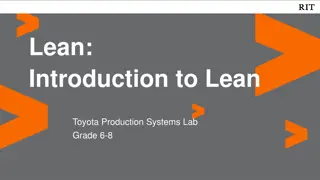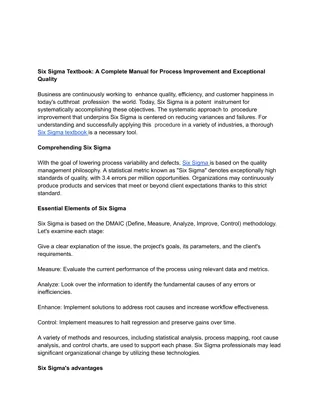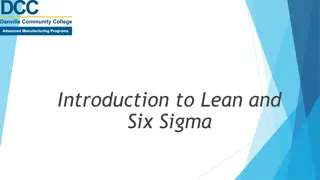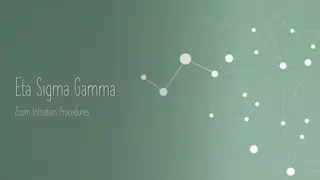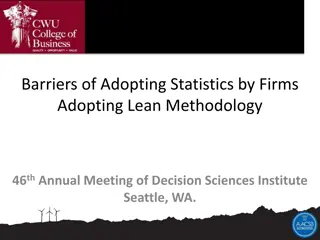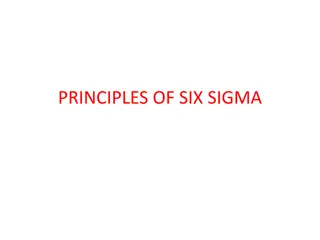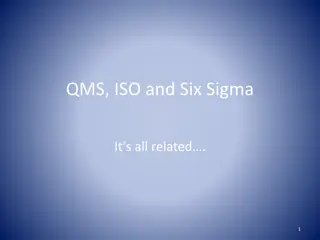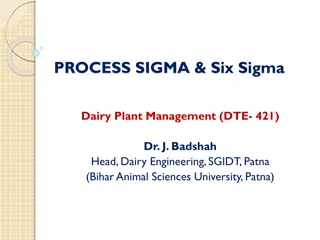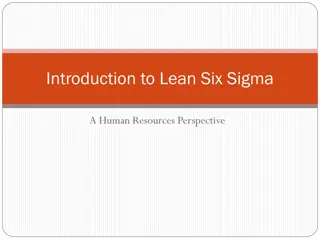
Strategic Model & Six Sigma: Improving Quality & Processes
Explore the strategic model for ISO-based QMS set standards, goals, 6 Sigma areas for improvement, lean thinking processes, and more. Learn about Six Sigma, TQM, and how to differentiate them in improving business processes effectively.
Download Presentation

Please find below an Image/Link to download the presentation.
The content on the website is provided AS IS for your information and personal use only. It may not be sold, licensed, or shared on other websites without obtaining consent from the author. If you encounter any issues during the download, it is possible that the publisher has removed the file from their server.
You are allowed to download the files provided on this website for personal or commercial use, subject to the condition that they are used lawfully. All files are the property of their respective owners.
The content on the website is provided AS IS for your information and personal use only. It may not be sold, licensed, or shared on other websites without obtaining consent from the author.
E N D
Presentation Transcript
Strategic Model Strategy ISO-based QMS Set Standards Goals 6 Sigma Strategic Areas for Improvement Lean Thinking Processes Projects Quick Wins Kaizen 2
Data and Facts Practical Problem Statistical Problem Statistical Solution Practical Solution 3
Eight-five percent of the reasons for failure to meet customer expectations are related to deficiencies in systems and process rather than the employee. The role of management is To Change The Process rather than badgering individuals to do better W. Edwards Deming 4
Summary This is not about sloganeering or bureaucracy or filling out forms. It finally gives us a route to get to the control function, the hardest thing to do in a corporation. -Jack Welch Former CEO of General Electric 5
Outline What is Six Sigma The Six Sigma Organization Leadership and Six Sigma 7
What is new about 6 Sigma? Reliance on tried and true methods with decades use: SPC Project management DOE __________ Is Six Sigma more or less complex than other quality systems? (i.e. TQM, etc.) Has little to do with traditional quality: Quality: conformance to internal requirements 8
TQM vs. Six Sigma TQM Defined Six Sigma Defined A methodology that provides businesses with the tools to improve the capability to their business processes. A management approach to doing business that attempts to maximize an organization s competitiveness through continual improvement of the quality of it s products, services, people, processes, and environments Compare 9
What differentiates Six Sigma from TQM? Strategy The hard tie to business strategy and business results The required commitment of top leadership up front and continuously through years of implementation Each project delivers bottom line results in a relatively short time 10
Defining 6 Sigma What is 6 Sigma? A vehicle for strategic change ... an organizational approach to performance excellence. TRANSFORMATIONAL CHANGE Across-the-board. Large-scale integration of fundamental changes throughout the organization --- processes, culture, and customers --- to achieve and sustain breakaway results. TRANSACTIONAL CHANGE Business processes. Tools and methodologies targeted at reducing variation and defects, and dramatically improving business results. 11
6 Sigma characteristics: Relentless quest for perfection Data-driven, fact-based decision making Focusing our best people on our highest priorities Improve the processes Rigorous alignment of actions with strategy Measuring bottom-line impact Transforming how people work 12
Mikel Harrys 6 Sigma Observations Selecting a tool is much like picking a spouse both make several assumptions. Black Belts are about ideas, quality engineers are about tools. There are key analytical ideas that every Black Belt should ponder and explore. If tools were the ticket, statisticians would be CEO s. A simple idea can often negate the need for a tool. The majority of a physician s curriculum is about knowledge, not scalpels. Six sigma is about the quality of business, not the business of quality 13
Defining 6 Sigma What is sigma? Sigma is the Greek letter that is a statistical unit of measurement used to define the standard deviation of a population. It measures the variability or spread of the data. 6 Sigma is also a measure of variability. It is a name given to indicate how much of the data falls within the customers requirements. The higher the process sigma, the more of the process outputs, products and services, meet customers requirements or, the fewer the defects. 14
Sigma vs. Cost of Poor Quality 30% 2 COPQ as a Percent of SALES 25% 3 20% 4 15% 5 10% 6 5% 69% 93.3% 99.4% 99.98% 99.9997% RTY (% DEFECT-FREE) *Derived from AlliedSignal internal study and experience 15
93% v 99.9% levels Examples of a world at 3 Sigma 54,000 wrong drug prescriptions per year 40,500 new-born babies per year dropped at delivery Usage drinking water 2 hours a month 5 crash landings per day at the busiest airports 54,000 lost pieces of mail per hour Examples of a world at 6 Sigma 1 wrong prescription in 25 years 3 new-born babies dropped in 100 year Unsafe drinking water 1 second every 16 years 1 crash landing in 10 years 35 lost pieces of mail per year 16
Potential Value With performance at 2 sigma: 69.146% of products and/or services meet customer requirements with 308,538 defects per million opportunities. With performance at 4 sigma: 99.379% of products and/or services meet customer requirements ... but there are still 6,210 defects per million opportunities. With performance at 6 sigma: 99.99966% As close to flaw-free as a business can get, with just 3.4 failures per million opportunities (e.g., products, services or transactions). Waste = potential quality actual quality 17
Three Levels of Benefits Allows for differentiation by: Nature of underlying benefit Confidencelevel in benefits achieved Provides latitude to drive behavior with quantifiable risk All Benefit Levels Are Important 18
Level I Benefits Nature Examples Direct impact Material cost reduction Warranty reductions Cancel external lease Enterprise headcount reduction Incremental volume; price realization Freight /scrap reduction Finance benefit on working capital improvements 90% confidence required Economic substance required Highest Confidence, Most Visible 19
Level II Benefits Examples Nature Productive redeployment of existing resources Equipment, buildings, etc. Whole persons Person productively redeployed in support of enterprise growth Equipment productively redeployed to a different plant/process thereby avoiding capital spend or outsourcing of operation Level II Redeployments Support Efficient Growth 20
Level III Benefits Nature Examples Avoidances Cost or capital avoidance Benefits otherwise Level I except for confidence achieved: Level I requires 90% Level III requires 70% Projects with significant upfront investments Incremental volume with 70% confidence Benefits measured on an NPV basis Efficiency gains resulting in manpower made available for redeployment Partial people efficiencies Salaried/mgmt. efficiencies partial person Whole people made available for redeployment Level III Critical to Growth and Quality 21
Why Measure the Financial Impact? Drives bottom line focus Forces value-added mindset of projects Ensures financial benefits from improvements are real Facilitates filtering and prioritization of projects What gets measured gets done! 22
Fiscal Benefits - Summary Six Sigma must pay it s way with quantifiable measures that trace savings to the bottom line. Level 1 Direct Fiscal Benefits Level 2 Re-deployment of personnel Level 3 Opportunities for Future Benefits Six Sigma must be fiscally self sustaining 23
Cost of Poor Quality Potential* Value Extraction Cost of Poor Quality is reduced via assignment of Black Belt Project Teams to Improvement Projects: Seasoned Black Belts complete three to four projects annually $175,000 - $200,000 average savings per project Annual savings delivered per Black Belt $575,000 - $800,000 Guidelines for number of Black Belts: 1% - 3% of employees 24
Six Sigma Philosophy Application of Scientific Method to design and operation of management systems and business processes to enable delivery of greatest value to customers and stakeholders Aligning core business processes with Customer and Business Requirements Systematically eliminating defects from existing processes, products, services, or plants Designing new processes, products, services, or plants that reliably and consistently meet Customer and Business Requirements Implementing the infrastructure and leadership systems to sustain gains and foster continuous improvement 25
6 Sigma Focuses on the Reduction of Variation that Generates Defects for Customers Market Critical Customer Requirements Process Outputs Business Processes Inputs Suppliers Defects Variation in the Process Output causes Defects that are seen by the customer Output Variation is caused by Variation in Process Inputs and by Variation in the Process itself 26
Fig. 3-8 27
Reducing the Process Output Variation Mean Critical Customer Requirement Variation Defects: Service unacceptable to customer Product or Service Output 28
Moving the Mean Mean Mean Critical Customer Requirement Defects: Service unacceptable to customer Product or Service Output 29
The Funneling Effect 59 Inputs All X s Process Maps MEASURE 17 1st Hit List C&E Matrix Failure Modes and Effects Analysis/FTA Multi-Vari Studies 8 ANALYZE Screened List IMPROVE Design of Experiments (DOE) 3 Found Critical X s CONTROL 2 Control Plans Controlling Critical X s Critical Input Variables 30
Application Plan Plan Act Do Study Study Study Study 31
6 Sigma Definitions 6 Sigma is 6 Sigma is not A highly technical method used by black belts to fine-tune products and processes. A goal of near perfection in meeting customer requirements (3.4 defects for every million opportunities). Decision-making by intuition. (It s rigor to enable results.) Focused on just defect reduction targets.(It s focused on delivering high quality, innovative solutions to our customers - to deliver high levels of shareholder value.) A flavor of the month. (It s the enabler of our new corporate strategy and listed as CSF #1. A global and passionate cultural change to position Caterpillar to achieve: $30B Sales & Revenues by 2006 $1.6B Cost Reduction by 2003 Quantum leap in Q&R Hard, but rewarding. Easy to implement.(Need to lead with clarity, consistency, and commitment.) 32
General 6 Sigma Critical Success Factors Establishing these factors provides the seeds of success. Business Process Framework They need to be integrated consistently to fit each business. Quantifiable Measures & Results Customer & Market Network Committed Leadership They are all necessary for the best result. Incentives & Accountability Strategy Integration The most powerful success factor is committed leadership. Full Time 6 Sigma Team Leaders 34
Strategy Defined The fundamental decisions and actions that guide an organization is, what it does, why it does it, with a focus on the future Strategic Planning is a disciplined effort to accomplish all these things Corporation: a collection of individuals that together, produce something that has less transaction cost than individually 35
Why Broad Transformation Efforts Fail Common shortcoming Description Effect Emphasis on quick hit impact results in a collection of projects with KPIs disconnected from business strategy Lackluster financial results Disconnect with strategy Program established by edict No thoughtful, coordinated effort to foster understanding of need for change among front line employees Uncommitted employees Temporary gains, followed by backsliding Ill-conceived communication plan I have watched a dozen change efforts Within two years, the useful changes that had been introduced slowly dispersed. Leaders of successful efforts use the credibility afforded by short- term wins to tackle even bigger problems Kotter, J. Why Transformations Fail, 1995 Little or no reporting to support ongoing performance management Transitory incentive systems Retrenchment from failure to reinforce positive behavior Unrealized potential Poor monitoring/ follow up Focus on process without incorporating specific operational expertise Ideas only as good as quality of problem solving Modest efficiency gains Undiscovered improvement opportunities Limited functional expertise Undue process-orientation and rigid approach results in unnecessary bureaucracy and delayed impact Program applied silo-by-silo, limiting ability to spot improvements in cross- cutting processes Cumbersome bureaucratic process Delayed impact Lost opportunities Rigid organizing structure 36
Implementing Six Sigma: 3 Basic On-Ramps Business Transformation Pros: rapid change, significant improvements in a few months Cons: chaotic, challenging to muster the time and people needed to meet the demands Strategic Improvement Pros: helps to focus on higher-priority opportunities, limits the challenges Cons: people feel left out in the process, uncertainty on how to align parts of the company that are doing Six Sigma with those that aren t - Problem Solving Pros: less disruptive, gives the company a chance to get a feel for how it works Cons: doesn t fix underlying problems or take a broad view of making change successful 37
Leadership Champion the process by understanding 6 Sigma and committed to success Guidance through creating vision by drawing mental images of future Visions embody abstract values; convert the abstractions 38
Visioning Stories are another way to communicate abstract ideas Event(s) occur that capture the essence of leader s vision May create situation with powerful symbolic meaning and use to communicate vision serves purpose for clarity 39

